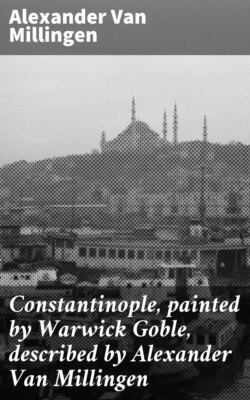Constantinople, painted by Warwick Goble, described by Alexander Van Millingen

Реклама. ООО «ЛитРес», ИНН: 7719571260.
Оглавление
Alexander Van Millingen. Constantinople, painted by Warwick Goble, described by Alexander Van Millingen
Constantinople, painted by Warwick Goble, described by Alexander Van Millingen
Table of Contents
CONSTANTINOPLE
CHAPTER I. the making of constantinople under constantine the great. 328-337 a.d
CHAPTER II. the making of constantinople, under the emperors constantius, julian, valens, theodosius the great, and arcadius. 337-408 a.d
CHAPTER III. the making of constantinople under theodosius ii. 408-447 a.d
CHAPTER IV. along the walls
Along the Walls beside the Sea of Marmora
CHAPTER V. along the walls beside the golden horn
CHAPTER VI. along the landward walls
CHAPTER VII. among the churches of the city
CHAPTER VIII. among the churches
CHAPTER IX. among the churches
CHAPTER X. impressions of the city to-day
CHAPTER XI. religious colouring
CHAPTER XII. turkish women
CHAPTER XIII. epilogue
INDEX
Отрывок из книги
Alexander Van Millingen
Published by Good Press, 2021
.....
Apart from the advantages offered by its situation, Byzantium had little to recommend it to Constantine’s regard. It presented neither ample room, nor a large population, nor convenient and splendid buildings to favour the rapid growth of a metropolis. Of the tongue of land on which the town stood, only the portion to the east of the line drawn from the present Stamboul Custom House, on the Golden Horn, across to the Seraglio Lighthouse, on the Sea of Marmora, was occupied. In the bay beside that Custom House lay the harbours of the town, where shipping, traders, and merchants did mostly congregate. The Acropolis stood on the rocky hill now enclosed within the Seraglio Grounds, and there several temples were found, that gods and goddesses might unite with men in the defence of the citadel. Against the steep side of the Acropolis, facing the blue expanse of the Sea of Marmora and the hills and mountains of the Asiatic shore, two theatres were built, while a stadium lay on the level tract beside the Golden Horn. The huge structure of the Hippodrome, which Severus had begun, was waiting to be completed, and to the north of it were the Baths of Zeuxippus and the adjoining public square which bore the same name. All this did not constitute a rich dowry for the future capital. But perhaps to the founder of Constantinople that fact was not a serious objection; the greatness and splendour of the new city were to be his own creation.
When precisely work upon the new capital commenced cannot be determined, but the year 328 a.d., as already intimated, may be regarded as the most probable date. The circuit of the fortifications which should guard the city was marked out by Constantine himself with solemn ceremonial, and comprised the territory that stretched for nearly two miles to the west of the old town. The north-western extremity of the enclosed area reached the Golden Horn somewhere in the neighbourhood of the Stamboul end of the Inner Bridge, while the south-western extremity abutted on the Sea of Marmora, at a point between the districts to which the Byzantine names Vlanga and Psamatia still cling. The most precise indication of the line followed by the landward wall of Constantine is found in the Turkish name Isa Kapoussi (the Gate of Jesus), attached to a locality above the quarter of Psamatia. The name refers to an ancient gateway which stood in the Constantinian fortifications, and survived their disappearance until the year 1508, when it was overthrown by an earthquake. It is mentioned in late Byzantine days as “The Ancient Gate,” and on account of its imposing appearance as “The very Ancient Beautiful Gate” (Antiquissima Pulchra Porta). It was the original Golden Gate or Triumphal Entrance of the city, and, like Temple Bar in London, reminded the passing crowds both of what the city had been, and of what it had become.
.....